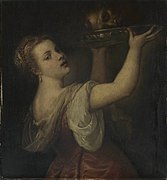- Anonymous copy of the Venetian School (c. 1550–1559)
- Copy by Franz von Lenbach (1868)
| Salome | |
|---|---|
 | |
| Artist | Titian |
| Year | c. 1550 |
| Medium | Oil on canvas |
| Dimensions | 87 cm× 80 cm(34 in× 31 in) |
| Location | Museo del Prado, Madrid |
Salome, also known as Salome with the Head of John the Baptist, is an oil on canvas painting by the Venetian painter Titian, made c. 1550. It is held in the collection of the Museo del Prado, in Madrid. It is not to be confused with other compositions of Salome and Judith by Titian.


